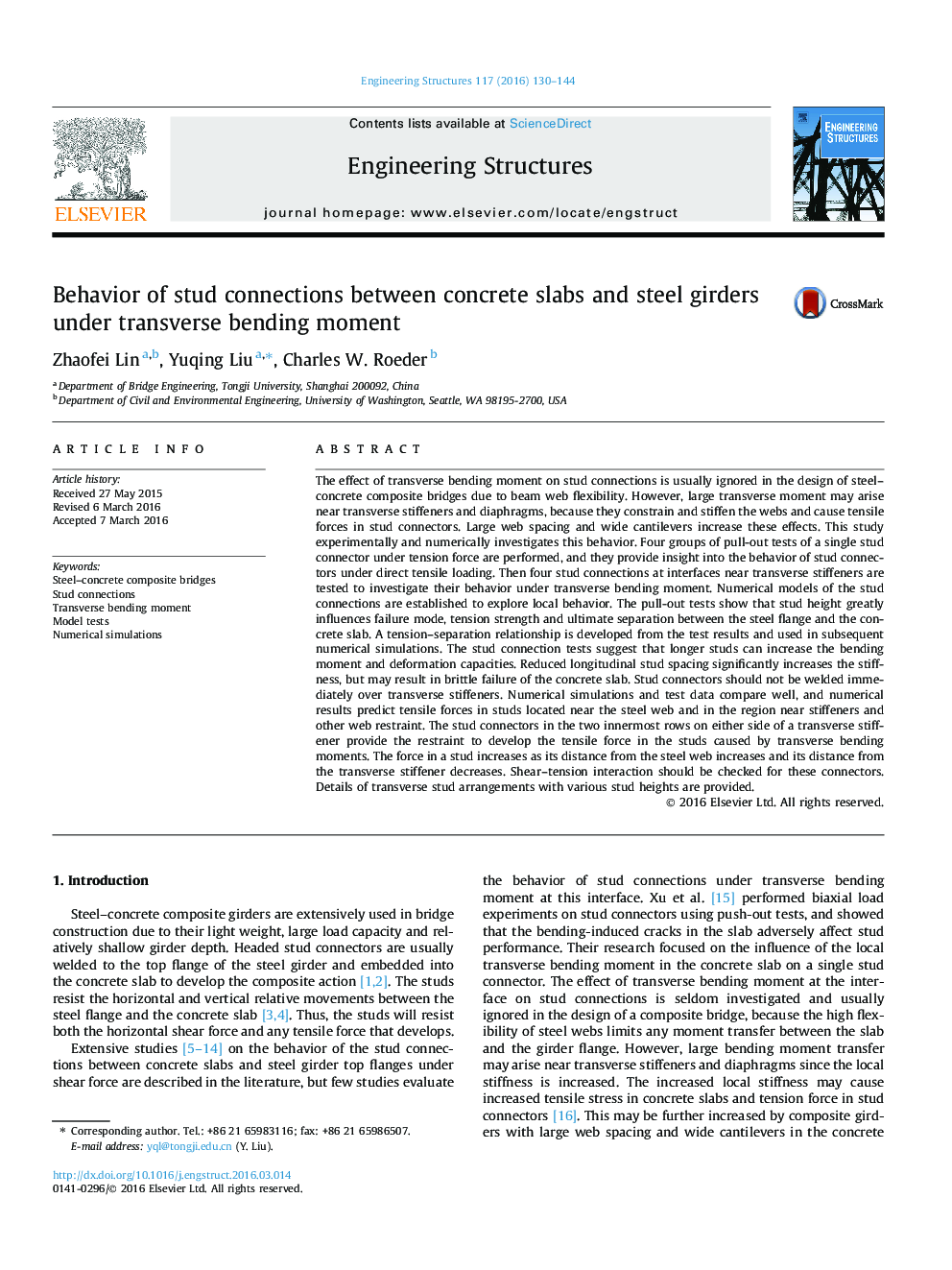| کد مقاله | کد نشریه | سال انتشار | مقاله انگلیسی | نسخه تمام متن |
|---|---|---|---|---|
| 6739940 | 504326 | 2016 | 15 صفحه PDF | دانلود رایگان |
عنوان انگلیسی مقاله ISI
Behavior of stud connections between concrete slabs and steel girders under transverse bending moment
ترجمه فارسی عنوان
رفتار اتصالات پایه ای بین اسلب بتونی و ستون های فولادی تحت لحظه خم شدن عرضی
دانلود مقاله + سفارش ترجمه
دانلود مقاله ISI انگلیسی
رایگان برای ایرانیان
کلمات کلیدی
فولاد پل های کامپوزیت بتن، اتصالات دانشجویی، لحظه خمشی برشی تست مدل، شبیه سازی عددی،
ترجمه چکیده
اثر موانع خمشی عرضی در اتصالات گل میخ معمولا در طراحی پلهای کامپوزیت فولادی به دلیل انعطاف پذیری پرتوهای پرتوهای نادیده گرفته می شود. با این حال، لحظات عرضی بزرگ ممکن است در نزدیکی مقاطع عرضی و دیافراگم ها بوجود آید، زیرا شبکه ها را محدود و سخت می کنند و باعث ایجاد نیروهای کششی در اتصال گره می شوند. فاصله بزرگ وب و کانتینر های گسترده باعث افزایش این اثرات می شود. این مطالعه تجربی و عددی این رفتار را بررسی می کند. چهار گروه از آزمایش های کششی یک اتصال تک گلوله تحت نیروی کششی انجام می شود و آنها را به رفتار اتصال اتصال گره تحت بار کششی مستقیم نگاه می کنند. سپس چهار اتصالات گل میخ در رابطهای نزدیک سفت کننده های عرضی برای بررسی رفتار آنها در لحظه خمش عرضی مورد آزمایش قرار می گیرند. مدل های عددی اتصالات گل میخ برای بررسی رفتار محلی ایجاد شده است. آزمایش های کششی نشان می دهد که ارتفاع گل میخ به شدت بر حالت شکست، قدرت کشش و جداسازی نهایی بین فلنج فولادی و بتونی بتن تاثیر می گذارد. رابطه جداسازی کششی از نتایج آزمون و در شبیه سازی های عددی بعد استفاده شده است. آزمایش اتصال اتصال نشان می دهد که میله های بلند می تواند لحظه خمشی و توانایی تغییر شکل را افزایش دهد. فاصله کاذب طولی کاهش یافته، سفتی را به طور قابل توجهی افزایش می دهد، اما ممکن است موجب شکست شکننده بلوک بتنی شود. اتصالات گل میخ نباید بلافاصله جوش بر روی سفت کننده های عرضی باشد. شبیه سازی های عددی و داده های آزمایشی به خوبی مقایسه می شود و نتایج عددی پیش بینی نیروهای کششی در ناحیه ها در نزدیکی وب فولاد و در منطقه نزدیک سفتنورها و سایر محدودیت های وب را پیش بینی می کنند. اتصال دهنده های گل میخ در دو ردیف داخلی که در هر طرف از یک سفتنده عرضی، محدودیت را برای توسعه نیروی کششی در ناخن ایجاد می کنند که ناشی از خم شدن عرضی است. نیرویی در یک گلدان به دلیل افزایش فاصله از ورق فولادی افزایش می یابد و فاصله آن از سلفر عرضی کاهش می یابد. برای این اتصالات باید بررسی تعامل با تنش برشی بررسی شود. جزئیات تراکم عرضی و ارتفاع گلدان های مختلف ارائه شده است.
موضوعات مرتبط
مهندسی و علوم پایه
علوم زمین و سیارات
مهندسی ژئوتکنیک و زمین شناسی مهندسی
چکیده انگلیسی
The effect of transverse bending moment on stud connections is usually ignored in the design of steel-concrete composite bridges due to beam web flexibility. However, large transverse moment may arise near transverse stiffeners and diaphragms, because they constrain and stiffen the webs and cause tensile forces in stud connectors. Large web spacing and wide cantilevers increase these effects. This study experimentally and numerically investigates this behavior. Four groups of pull-out tests of a single stud connector under tension force are performed, and they provide insight into the behavior of stud connectors under direct tensile loading. Then four stud connections at interfaces near transverse stiffeners are tested to investigate their behavior under transverse bending moment. Numerical models of the stud connections are established to explore local behavior. The pull-out tests show that stud height greatly influences failure mode, tension strength and ultimate separation between the steel flange and the concrete slab. A tension-separation relationship is developed from the test results and used in subsequent numerical simulations. The stud connection tests suggest that longer studs can increase the bending moment and deformation capacities. Reduced longitudinal stud spacing significantly increases the stiffness, but may result in brittle failure of the concrete slab. Stud connectors should not be welded immediately over transverse stiffeners. Numerical simulations and test data compare well, and numerical results predict tensile forces in studs located near the steel web and in the region near stiffeners and other web restraint. The stud connectors in the two innermost rows on either side of a transverse stiffener provide the restraint to develop the tensile force in the studs caused by transverse bending moments. The force in a stud increases as its distance from the steel web increases and its distance from the transverse stiffener decreases. Shear-tension interaction should be checked for these connectors. Details of transverse stud arrangements with various stud heights are provided.
ناشر
Database: Elsevier - ScienceDirect (ساینس دایرکت)
Journal: Engineering Structures - Volume 117, 15 June 2016, Pages 130-144
Journal: Engineering Structures - Volume 117, 15 June 2016, Pages 130-144
نویسندگان
Zhaofei Lin, Yuqing Liu, Charles W. Roeder,
